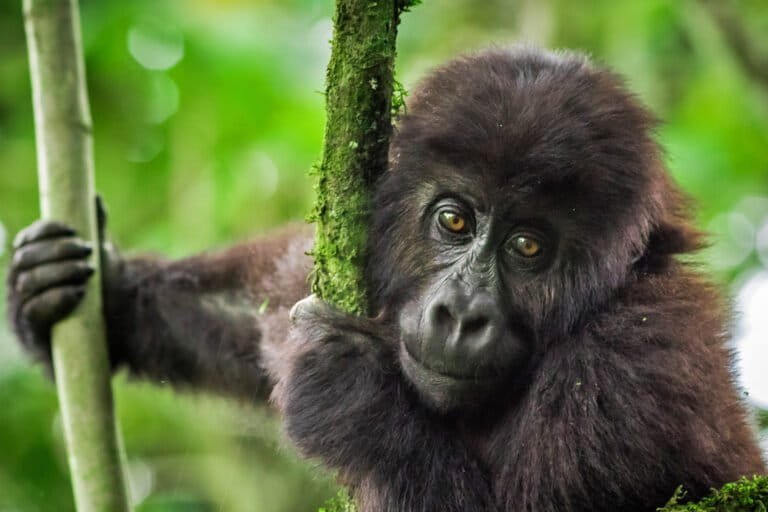At a summit in 2010, the world’s 13 tiger range states pledged to double the number of tigers (Panthera tigris) in the wild by 2020. Today, non-tiger state Germany announced its assistance toward that end. Through its KfW Development Bank, the German government has pledged around $27 million (20 million Euro) to a new program run by the International Union for Conservation of Nature.
“This generous support from Germany provides great hope for this iconic species, which is currently on the brink of extinction. Saving the tiger depends on restoring its rapidly shrinking forest habitat,” says Julia Marton-Lefèvre, IUCN Director General.
The monies will go to a five year program, dubbed the Integrated Tiger Habitat Conservation Programme, which will divvy out funds to conservation groups and wildlife authorities in select tiger range countries.
 Malayan tiger. Photo by: Rhett A. Butler. |
Experts estimate that only around 2,500 tigers survive in the wild today, less than the number of tigers found in captivity in the U.S. alone and a 97 percent population drop from a century ago. The IUCN Red List categorizes the species as Endangered. Furthermore, out of nine subspecies, three are already extinct and two are listed as Critically Endangered.
The world’s remaining tigers are imperiled by deforestation, habitat destruction, poaching for tiger parts, prey decline, disease, human-tiger conflict, and booming human populations across much of their range. As top predators, tigers are considered a keystone species for functioning, healthy ecosystems.
Countries eligible for the new program include: Bangladesh, Bhutan, Cambodia, India, Indonesia, Laos, Myanmar, Nepal and Vietnam.
Related articles
Indonesia police nab illegal wildlife traffickers in sting operation

(01/12/2014) Police in Indonesia’s Aceh province have arrested two wildlife trafficking suspects allegedly behind five tiger poaching rings operating in the forests of northern Sumatra. The arrests followed a months-long investigation and an undercover sting operation in which police seized thousands of dollars worth of illegal animal parts.
Over 75 percent of large predators declining

(01/09/2014) The world’s top carnivores are in big trouble: this is the take-away message from a new review paper published today in Science. Looking at 31 large-bodied carnivore species (i.e those over 15 kilograms or 33 pounds), the researchers found that 77 percent are in decline and more than half have seen their historical ranges decline by over 50 percent. In fact, the major study comes just days after new research found that the genetically-unique West African lion is down to just 250 breeding adults.
Bangladesh plans massive coal plant in world’s biggest mangrove forest

(11/11/2013) On October 22nd Bangladeshi and Indian officials were supposed to hold a ceremony laying the foundation stone for the Rampal power plant, a massive new coal-fired plant that will sit on the edge of the Sundarbans, the world’s largest mangrove forest. However, the governments suddenly cancelled the ceremony, instead announcing that the project had already been inaugurated in early October by the countries’ heads of state via a less-ornate Skype call. While the governments say the change was made because of busy schedules, activists contend the sudden scuttling of the ceremony was more likely due to rising pressure against the coal plant, including a five-day march in September that attracted thousands.
Scientists: to save the Malayan tiger, save its prey

(10/31/2013) A major premise of biology, as any high-schooler can tell you, is the study of the connections between organisms. Perhaps nowhere is there a better example of this than in Malaysia, where the population of Endangered Malayan tigers (Panthera tigris jacksoni) is being undercut by dwindling prey. A recent study by MYCAT, the Malaysian Conservation Alliance for Tigers, highlights this connection by presenting a distinct correlation between prey and tiger population.
Stuffed tigers send two soldiers to jail in Indonesia
(10/28/2013) A military court in Indonesia’s Aceh province has jailed two soldiers for illegally possessing two stuffed Sumatran tigers (Pathera tigris sumatrae) and a stuffed sun bear (Helarctos malayanus), a rare verdict in the Sumatran province where crimes involving wildlife are seldom prosecuted.
Featured video: how tigers could save human civilization
(08/29/2013) In the video below, John Vaillant, author of the The Tiger: A True Story of Vengeance and Survival, tells an audience at TEDxYYC about the similarities between tigers and human beings. Given these similarities—big mammals, apex predator, highly adaptable, intelligent, and stunningly ‘superior’—John Vaillant asks an illuminating question: what can we learn from the tiger? It turns out learning from tigers could help conserve the human race.
(07/30/2013) Nearly two hundred tigers roam the lowland forests of Nepal, according to a new survey. This is a 63 percent increase in the country’s tiger population since 2009, and rare good news for global efforts to save the tiger from extinction.
Zoos call on governments to take urgent action against illegal wildlife trade (photos)

(07/24/2013) In a single night in March, a band of heavily-armed, horse-riding poachers slaughtered 89 elephants in southern Chad, thirty of which were pregnant females. The carnage was the worst poaching incident of the year, but even this slaughter paled in comparison to the 650 elephants killed in a Cameroon park in 2012. Elephant poaching is hitting new records as experts say some 30,000 elephants are being killed every year for their ivory tusks. But the illegal wildlife trade—estimated at $19 billion—is not just decimating elephants, but also rhinos, big cats, great apes, and thousands of lesser-known species like pangolins and slow lorises. This growing carnage recently led to representatives of over 40 zoos and dozens of wildlife programs to call on governments around the world to take immediate action on long-neglected wildlife crime.














